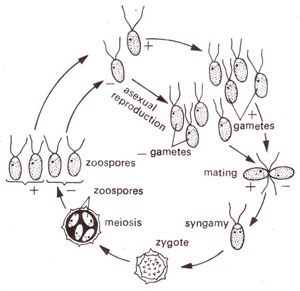Meiosis

Fig. 7.5. Sexual reproduction cycle in Chlamydomonas.

Fig. 7.6. Alternation of generations in Bryophytes.
It is obvious from the study of mitosis that daughter cells resulting from a mitotic division have same chromosome number as the parent cell had. This is necessary for growth and reproduction, if only asexual method is present. However, in sexual method of reproduction, fusion of sex cells (male and female) is required. If sex cells have the same chromosome number as the somatic cells have, the zygote will have double the chromosome number. For instance, if an individual has four chromosomes in each cell including the sex cells, the zygote resulting from fusion of the two sex cell will have eight chromosomes and an individual having eight chromosomes in each cell would result. This cycle will repeat in each generation and with each cycle of sex cells fusion, chromosome number will be doubled again and again. This will be a difficult situation.




